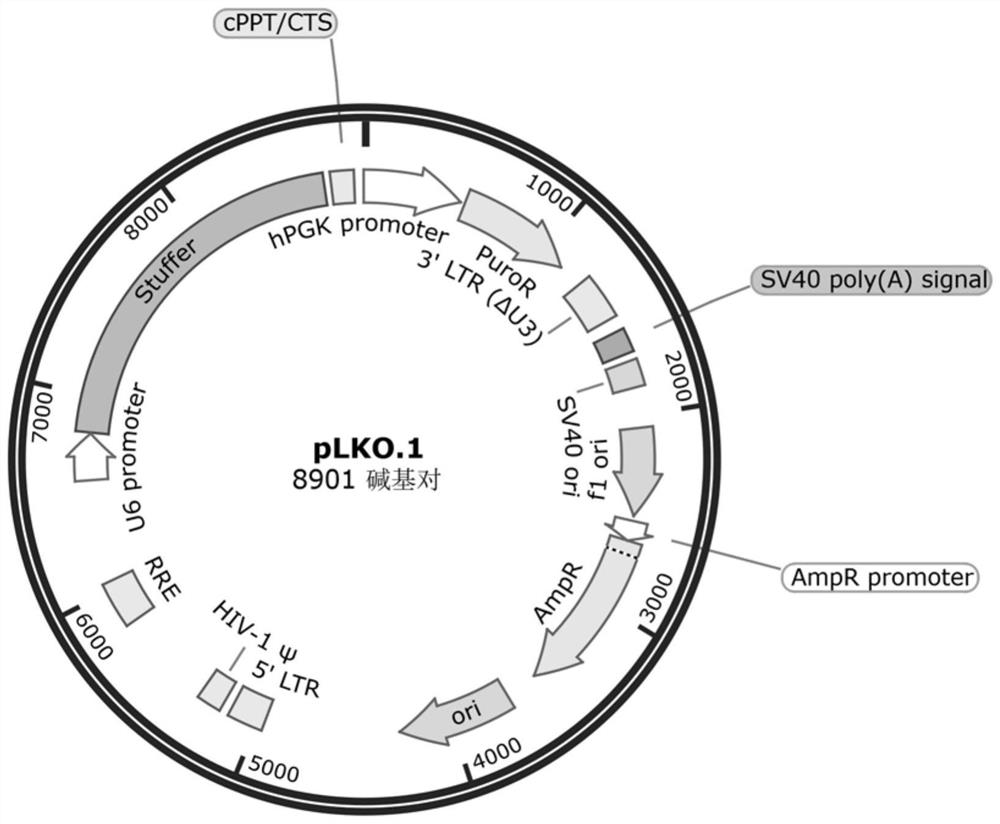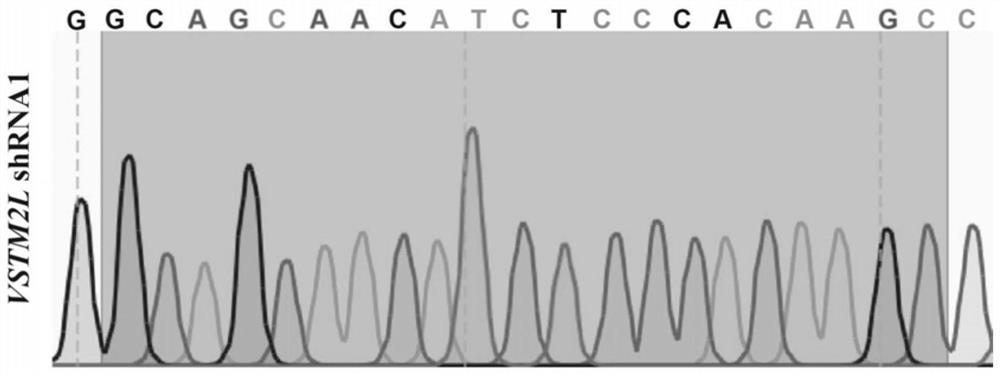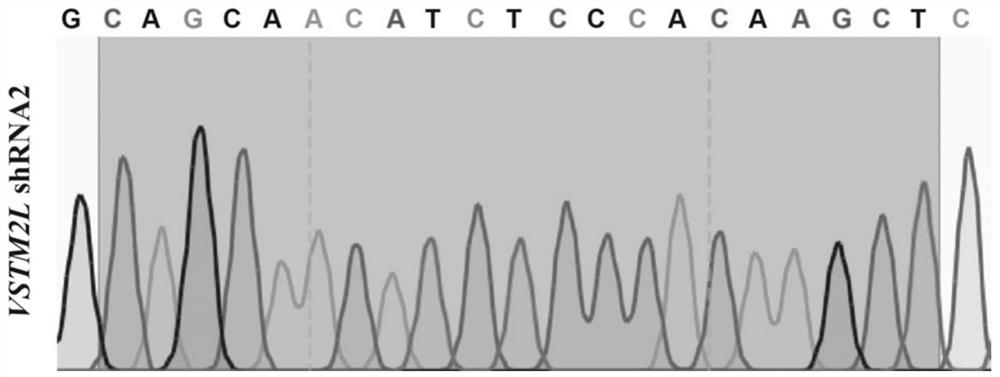Lentiviral vector for inhibiting expression of VSTM2L and application of lentiviral vector
A lentiviral vector and lentiviral technology, applied in the field of genetic engineering, can solve the problem of not inhibiting VSTM2L lentiviral vector
- Summary
- Abstract
- Description
- Claims
- Application Information
AI Technical Summary
Problems solved by technology
Method used
Image
Examples
Embodiment 1
[0033] Construction of VSTM2L gene shRNA lentiviral vector
[0034] (1) Design and synthesize shRNA
[0035] In this example, two shRNA nucleotide sequences targeting the CDS region of VSTM2L or the 3'UTR are designed, respectively:
[0036] VSTM2L-shRNA1:GCAGCAACATCTCCCACAAGC
[0037] VSTM2L-shRNA2: CAGCAACATCTCCCACAAGCT
[0038] After designing the shRNA nucleotide sequence, insert the shRNA nucleotide sequence according to the following structure to obtain two pairs of shRNA oligonucleotide sequences (sense is the shRNA sequence, and anti-sense is the complementary sequence):
[0039] Forward oligo: 5'CCGG-21bp sense-CTCGAG-21bp anti-sense-TTTTTG 3';
[0040] Reverse oligo: 5'AATTCAAAAAA-21bp sense-CTCGAG-21bp anti-sense 3';
[0041] After the design is completed, it will be synthesized by Shanghai Sangon Bioengineering Co., Ltd. The final shRNA oligonucleotide sequence targeting VSTM2L obtained is as follows:
[0042] VSTM2L-shRNA1:
[0043] Forward oligo: 5’-CCGGGCA...
Embodiment 2
[0051] Preparation of lentivirus targeting the VSTM2L gene
[0052] (1) HEK293T cell culture
[0053] HEK293T cells used in this example were purchased from the American Type Culture Collection (ATCC), and were cultured in DMEM high-glucose medium containing 10% fetal bovine serum at 37°C, 5% CO 2 In the incubator, cells were passaged when they reached 90% confluency. The day before lentivirus packaging, HEK293T cells were trypsinized and then seeded into 6-well plates. After culturing for 24 hours, the cells were completely adherent and the cell density reached 60-70% before proceeding to the next step.
[0054] (2) Lentiviral packaging
[0055] Lentiviral packaging can be performed when HEK293T cells grow to 60-70%. The following operations only represent the dosage for one well of a six-well plate: Take two 1.5mL sterile centrifuge tubes, add 125μL opti-MEM to the first centrifuge tube to dilute the lentiviral packaging plasmids pMD2.G (375ng), psPAX2 (1125ng) and pLKO....
Embodiment 3
[0057] Construction and identification of a lentiviral vector cell line that effectively inhibits the expression of VSTM2L
[0058] (1) Culture of prostate cancer cells
[0059] Prostate cancer cell line 22Rv1 was purchased from the American Type Culture Collection (ATCC), and was cultured in complete RPMI-1640 medium containing 10% fetal bovine serum and 1% double antibody at 37°C, 5% CO 2 In the incubator, cells can be passaged when they reach 90% confluency.
[0060] (2) Construction of 22Rv1 cell line that effectively inhibits the expression of VSTM2L
[0061] First, the 22Rv1 cell line in the logarithmic growth phase was digested with trypsin for 5 min, and after the digestion was neutralized with 2 times the volume of trypsin, the digested cells were carefully blown off and collected into a 15 mL centrifuge tube at 800×rpm. , centrifuge for 3 min, discard the supernatant, collect the cells at the bottom of the centrifuge tube; then, add 1 mL of RPMI-1640 complete mediu...
PUM
 Login to View More
Login to View More Abstract
Description
Claims
Application Information
 Login to View More
Login to View More - R&D Engineer
- R&D Manager
- IP Professional
- Industry Leading Data Capabilities
- Powerful AI technology
- Patent DNA Extraction
Browse by: Latest US Patents, China's latest patents, Technical Efficacy Thesaurus, Application Domain, Technology Topic, Popular Technical Reports.
© 2024 PatSnap. All rights reserved.Legal|Privacy policy|Modern Slavery Act Transparency Statement|Sitemap|About US| Contact US: help@patsnap.com










